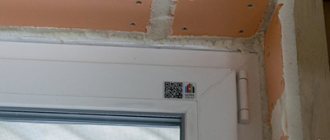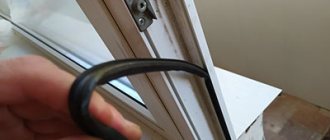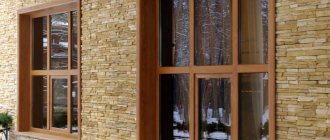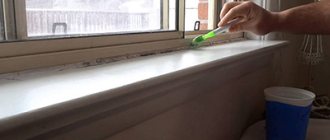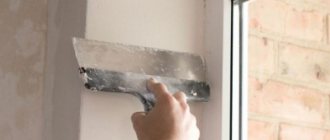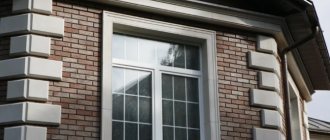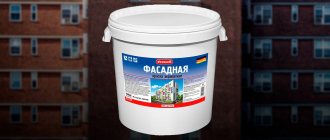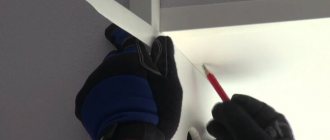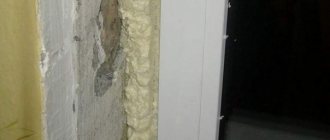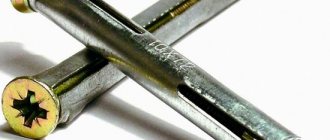After the window system is installed, it is necessary to install external slopes for plastic windows. Postponing this process “for later” is not recommended for several reasons. The external decoration of the window opening is designed to give it a finished, neat appearance.
The second reason is more significant and practical. It is connected with the performance properties of polyurethane foam, which is used to fasten PVC windows in the opening and fills the installation seam, protecting the room from the penetration of precipitation, noise, pollution and wind from the street. However, this material itself needs protection, which can be provided by external slopes on the windows.
Purpose of external slopes
Polyurethane foam, which is used when installing PVC windows, does not imply its operation in a form unprotected from external influences.
Slopes protect the polyurethane foam from external influences
In direct sunlight, polyurethane foam will deteriorate within a few months. The loss of foam’s qualities entails improper functioning of the window system as a whole: from loss of energy efficiency to violation of the geometric position in the window opening, accompanied by mechanical breakdowns of control systems.
The finishing of plastic windows can be delayed for a short period of time, but it is better that it be done “hot on the heels”.
In addition to the sun, moisture is a threat to polyurethane foam. At first, water does not penetrate the material. But when, under the influence of the sun, its structure is disrupted, moisture easily penetrates into the pores of the polyurethane foam, having a destructive effect on it.
Due to the fact that foam is a porous material, it will invariably allow moisture from the room to pass through, albeit in small quantities. As a result, condensation will form, which will lead to the formation of fungus and mold on the walls.
To summarize, we can highlight the following functions characteristic of external slopes for plastic windows:
- protecting walls from condensation;
- window protection from fogging;
- heat and sound insulation of the room;
- increasing the service life of the window system;
- Give the window opening and facade a generally neat appearance.
Nice drawings on the window
Decorate beautiful and simple windows for the new year with your hands and place them on the windows with new year drawings.
To do this, you only need toothpaste diluted with water.
How to do this in different ways:
Make a small round sponge. To do this, make a piece of foam rubber, lay it down and secure it with self-adhesive tape so that it does not turn. The dissolved toothpaste is placed in a plate, brushed and pressed onto the window, leaving a dot, taking a fir branch. If you have templates at home, you can prepare Christmas toys and animals. When the paste is dry, rub all parts with a sharp fork.
The second method is based on spray technology - very original drawings were obtained. First, cut the snowflake and attach it to the window. Then take a toothbrush and thoroughly soak it in the toothpaste, then press down on the bottom bristles and spray the mixture onto the snowflake. When it dries, remove the snowflakes. There will be a beautiful path on the glass.
The first spray is very large, so first you need to shake the toothbrush and get rid of excess moisture.
You can also draw not only toothpaste, but also an old crowbar, but here you will need a little talent.
Types of materials
Exterior finishing of windows can be done with various materials, which create different decorative effects and levels of protection for the installation seam due to their properties.
| Plaster | |
| Plastic | |
| Sandwich panel | |
| Metal | |
| Styrofoam |
Plaster slopes
Finishing plastic windows from the outside using plaster is a traditional and inexpensive method . Despite the apparent simplicity of working with this material, an untrained person will not be able to do a quality job, since one must have certain professional skills. But you can take a risk and make external slopes with your own hands using plaster. How to make slopes on windows in this way will be described below.
High-quality plastering of external slopes requires certain skills
In order for plastered slopes on windows from the street to look neat, it is necessary to ensure their even geometric parameters. To do this, it is recommended to set beacons, focusing on which, you can achieve an even application of the plaster layer.
Preparation and execution of work
The work begins with preparing tools and purchasing plaster for exterior work.
First you need to prepare tools and buy plaster for exterior work.
- Surface preparation involves removing excess foam using a construction knife. Then all visible cracks and holes are cleaned in order to putty them. You can foam them, and then also cut off the excess.
At the first stage, remove excess foam and seal the cracks - Then a metal casting is installed. Excess foam from the bottom is removed, the remaining is covered with plaster mortar. The ebb is “planted” onto the mounting foam or liquid nails. Then it is secured to the frame or stand profile using self-tapping screws.
The ebb is secured with self-tapping screws - They put up beacons.
To plaster the slope it is necessary to install a beacon - Using a trowel or metal spatula, spread the plaster mortar so that it is slightly higher than the beacons. Then, using a rule or a wide spatula, work from bottom to top until a smooth surface is obtained.
Distribute the solution using a rule or a wide spatula - During work, it is recommended to reinforce the corners.
When plastering corners, use reinforcing mesh - After the plaster layer has completely dried, it is sanded.
Final grinding of the surface is carried out after the plaster has dried.
Wet finishing method
This cladding variation is the most traditional and economical option. The simplicity and simplicity of this method makes it possible to plaster and paint the slopes yourself. To finish the surface, you need to prepare a dry mixture based on cement or gypsum. It should be noted that this type of work differs in the duration of the manipulations performed. And also the “fur coat” needs to be dyed periodically.
Before plastering external walls, they should be prepared. Preparation consists of cleaning from dirt, defects, and excess foam. To protect the window, it is recommended to cover the structure with masking tape. Plastering slopes should be done in stages:
- The first step is to install the beacons at a distance of up to 5 cm from the window frame; fixation is done with nails.
- The thickness of the plaster layer should cover the window by 1 cm. The generally accepted thickening is 2 cm. The corners should be aligned with a square.
- After making sure that the opening is clean, it is possible to apply a primer. Priming is intended to improve the adhesion of the plaster to the base.
Puttying external slopes
- The cement-gypsum mortar should be applied over the beacons and smoothed with a spatula. Manipulations must be done from the bottom up.
- After the first layer has dried, the beacons should be removed, and the locations should be covered and leveled.
- 1 layer of plaster should not exceed 7 mm. It should be taken into account that it is correct to apply a new layer of plaster only on the dried previous layer. Also, don't forget about angular alignment.
- After the plaster has set, the wooden frame is removed, and the defects are covered and smoothed.
- You can slightly moisten the coating with a wet rag and remove any imperfections using a grater.
- After thorough drying, whitewash or paint is applied.
The window must be closed during work. Because if the mixture penetrates into the fittings, functionality may be impaired. An obvious negative property of the finishing method is the failure to combine the cement mortar with the PVC profile. This contributes to the appearance of a hole between the slope and the frame base. Therefore, the resulting gaps should be sealed with silicone-based sealant.
Plastic slopes
Finishing windows with plastic is one of the most common methods due to the following advantages of PVC:
- the glossy surface of the plastic naturally matches the appearance of the window profile;
- the plastic surface can be laminated, giving it any color or imitation of the texture of natural wood;
- the material has a low level of thermal conductivity, therefore virtually eliminating the formation of condensation on its surface;
- it is easy to care for;
- it has a long service life;
- street slopes made of plastic are easy to install;
- It has low weight, so it does not load the wall structure.
Plastic panels are most often used for finishing external slopes.
Among the disadvantages of plastic street slopes, it can be noted that when using low-quality plastic, you can observe its yellowing over time . At low temperatures, the plastic becomes brittle and if it is damaged, the entire fragment will have to be replaced.
Decorative elements for window framing
Agree, you won’t surprise anyone today with ordinary slopes. How then can you improve the appearance of your home? For these purposes, various elements and techniques are used that can be combined with the previously described types of slopes.
1.You can frame the windows with polyurethane linings. They are installed with glue, so you need to ensure a level base with good adhesion. They are also suitable for brick walls.
Polyurethane pads
2. Smooth plastered slopes will serve as an excellent basis for finishing with various decorative materials. The photo shows an option for decorating the outside of a window with decorative artificial stone. Clinker and porcelain tiles will also look beautiful.
Decorative stone cladding
3. Extruded polystyrene foam is also used for similar purposes. Such systems consist of corner elements and a straight profile. Everything is put on glue. You can choose any color from those available, or paint the material yourself.
Foam frame
4. In cases of updating the facade using decorative brickwork, the windows can be lined separately with shaped products to give them an unusual, beautiful look.
The perimeter of the windows is lined with figured bricks
5. At an affordable price, you can use the services of professional craftsmen who can create such stucco masterpieces. Such windows look very beautiful, luxurious and rich.
Stucco around the window
6. Sandrik is a small architectural element above the window, which can be made of concrete, plaster, polyurethane and foam. The difficulty of installing the part depends on the material.
Above the window there is a decorative element - sandrik
7. A pyramidal or wedge-shaped decorative element made from the same materials. Installed at the top of a vault or arch, above the window.
Keystone at the top of the window
8. You can install a false baluster under the window.
Baluster falsehood
It is worth noting that determining the necessary decorative elements is quite a complex matter. If you overdo it, then instead of beauty you will end up with wild pretentiousness and bad taste, so do not be afraid to consult professionals. Of course, they charge money for their services, but remember that you are creating the appearance of the house and will be looking at it for many years, and only positive emotions should arise from contemplation for you and the audience.
Read more about the decorative elements of the facade in a special article.
Installation
- finishing the slopes of windows from the outside with plastic panels begins with preparing the surface - cleaning it and sealing the cracks;
- measurements are taken on each side, the side fragments are measured in two places - at the window and at the wall due to the presence of a slope;
- the perimeter of the window opening is framed with wooden slats, to which the starting profile is attached using a construction stapler. A plastic element will go into it;
- corners are formed using an f-shaped profile or external slopes with platbands are arranged.
Installation diagram of a plastic slope
Considering the existing disadvantages of this material, it is better to use it for interior work.
Drywall slopes
Exterior finishing of windows using drywall is a dubious undertaking. GKLV brand plasterboard can be used when finishing the external slopes of windows facing a glazed loggia or balcony. Before installing this material, the surface of the base must be treated with an antiseptic. Installation can be carried out with or without insulation.
The surface of drywall can be decorated in any way.
It would be a mistake to install external plasterboard slopes on window openings exposed to direct exposure to precipitation. This material is not suitable for outdoor use .
Sandwich panel slopes
Finishing the external slopes of plastic windows with sandwich panels is an inexpensive and common method. It is characterized by the following qualities:
- finishing window openings with this material allows you to obtain a decorative, neat appearance of the window opening;
- the outer plastic surface can be covered with lamination of any color or imitate the texture of natural wood;
- has insignificant weight due to the use of foamed polyurethane foam as an insulating layer;
- you can arrange external slopes with platbands;
- due to the multilayer nature of the material, such finishing of the window opening allows for decent heat and sound insulation of the room;
- simple installation will allow even a non-professional to make external slopes on windows with his own hands;
- slopes for windows made of sandwich panels have a long service life;
- Such window slopes are easy to maintain - it is enough to occasionally wet clean them.
Among the disadvantages, the following can be noted: in the summer, from direct sunlight, the outer surface of the panels may turn yellow.
It is also worth considering that the material is sold in the form of dimensional panels, so you need to be prepared for difficulties with transportation. Some stores offer a service for sawing large panels into pieces of the required size. Slopes made of sandwich panels are installed in the same way as indoors.
The need for insulation - how and how to insulate
Insulation of slopes helps retain heat in the room and prevents an increase in humidity inside the room. Let's consider possible insulation options that are advisable to use in this case:
- mineral wool – is moisture resistant, provides thermal insulation for the window and reliably protects against the penetration of external noise. The insulation must be fixed to a special mesh that is glued to the wall;
- polystyrene foam – has good heat and sound insulating properties, easy to install. You can purchase ready-made foam slopes. Mounted on metal profiles;
- expanded polystyrene - a waterproof cellular material with high thermal insulation properties;
- Sandwich panels are an option for finishing, endowed with heat-insulating properties - the middle layer is made of extruded polystyrene foam.
Foam slopes
When finishing plastic windows with your own hands, you can make slopes on the windows from foam plastic.
A foam slope does not require insulation
This is an interesting example of how to make street slopes for windows, but it is short-lived. Such external slopes are made simply, the main thing is to take the necessary dimensions and cut out the parts.
Polystyrene foam has many positive qualities, which makes it possible to use it when finishing external slopes:
- external slopes made of foam plastic are maximally insulated;
- high sound insulation in the house is ensured;
- polystyrene foam does not rot or become moldy;
- simple installation - making external slopes from this material is very simple;
- the work is done quickly, since there is no need to make complex preparations;
- if you install elements made of this material on plastic windows, then you don’t have to be afraid that a load will be placed on the structure - polystyrene foam has the lightest weight among all finishing materials;
- polystyrene foam is easy to process, so you can give the part any size;
- The surface of this material is then finished with plaster or painted.
This material can be used to insulate the walls of a house along with the accompanying design of window openings.
External window trim with plasterboard
Another inexpensive option is finishing with plasterboard. Typically this material is used for interior work due to insufficient moisture resistance. But it is also quite suitable for cladding external slopes if the windows overlook a glazed loggia, balcony or terrace. Moisture-resistant drywall is suitable for these purposes.
It allows you to quickly create a perfectly flat surface, which facilitates the process of applying plaster. Before installing the slabs, it is necessary to thoroughly treat the surface with an antibacterial compound.
Advantages of finishing with plasterboard:
- Affordable price of material;
- Easy installation;
- Light weight, which makes work easier;
- Good thermal insulation ability.
Disadvantages of finishing slopes with plasterboard:
- Low strength - even a not very strong blow can lead to the formation of potholes, dents and chips;
- Low moisture resistance.
Metal slopes
There are various types of external slopes, but the best are metal products.
External slopes made of metal have high strength
They are made of galvanized steel. The outer part of the product is powder coated, which ensures durability of the coating and protection against corrosion and rust.
Positive qualities of metal slopes:
- durability and aesthetic appearance;
- heat and sound insulation of premises;
- reliable protection from natural phenomena;
- easy installation and maintenance.
How to properly install the metal fragment is shown below.
Installation diagram of a metal slope
Slopes made of natural stone
Using natural or artificial stones is not the cheapest way, but on the facade of a house such finishing looks very impressive.
Stone slopes do not absorb moisture at all
Natural stones have all the necessary qualities to be used as exterior decoration . They are durable, have a beautiful appearance, and are varied in their design. They have protective, heat and sound insulating qualities. They do not absorb moisture at all. You can decorate the openings with bricks or use various artificial and natural stones.
